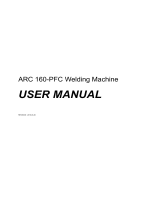
326 |
WELDING GLOSSARY
Welding technology from A to Z.
AC
Abbreviation for Alternating Current.
Electrode and TIG welding can be carried
out with direct current and alternating
current. TIG aluminium welding must be
carried out with alternating current.
ANALOGUE CURRENT SOURCE
A current source that is controlled by
resistances. Formerly used in expensive
industrial systems. Hardly used today due
to high costs and inflexibility.
ANTI-STICK MECHANISM
If the electrode gets stuck to the workpiece,
the welding current is turned off. The
electrode doesn‘t anneal and can be easily
removed from the workpiece.
ARC-FORCE REGULATION
The welding output is kept constant at the
set value as far as possible for electrode
welding. The electric arc burns steadily
(even with difficult electrodes or positions).
Advantage: The welding result is more even.
BALANCE CONTROL
TIG AC welding. By shifting the ratio from
negative proportion to positive proportion,
more or less fusion penetration is achieved
on the workpiece. As opposed to fusion
penetration, the tungsten electrode gets
hotter or colder.
IDLE POWER
Power consumed by a device from the mains
that is not converted to welding power.
DC
Abbreviation for Direct Current. MIG/MAG
welding for example, is carried out with
direct current.
DIGITAL CURRENT SOURCE
Microprocessor-controlled
current source.
DIODE
Electronic component (semi-conductor).
Converts alternating current into direct
current one-way by a blocking effect.
CHOKE
A wound copper coil with iron core. Serves
as energy storage unit. Provides a smooth,
low-splatter electric arc, thus achieving ideal
welding results. Also see induction coil.
DUTY CYCLE
Theoretical value for the capacity of a
welding device. Is calculated according to
standards with 10 min. and specified in %.
(e.g. 40% ED = 4 min. welding at max. output,
6 min. break). The device does not heat up
too strongly, as it is switched off thermally.
FORMING GAS
Nitrogen or nitrogen with up to 50% hydro-
gen. For protecting roots (opposite sides)
of weld seams when welding high alloy
steel before oxidation. The corrosion
resistance is maintained.
GAS POST FLOW TIME
Adjustable time that lets the gas continue
to flow after the welding process. Is for
protecting the glowing tungsten electrode
and the welded product from atmospheric
influences.
RECTIFIER
For wiring multiple diodes. Converts
alternating current into direct current
multi-way by a blocking effect.
HIGH FREQUENCY IGNITION
Ignites the electric arc during TIG welding
without touching the workpiece. Due to a
high voltage pulse, the air gap between the
workpiece and the tungsten needle is
electrically conductive (ionised).
HOT START
Hot-start ignition aid for igniting the electric
arc of an electrode rod during electrode
welding. The electric arc ignites immediately
and steady due to an automatic and
temporary increase of the welding current.
INDUCTION COIL
A coil wound with copper wire. Acts like an
energy buffer and helps to optimise the
welding current. Also see choke.
INSULATION CLASS
Specifies how hot the transformer’s
insulation may get without causing
damage. The temperature is monitored
by a thermal switch, e.g. F = 155°C.
CONTACT IGNITION
Also called surface ignition. To ignite
the electric arc during TIG welding, the
tungsten needle must touch the workpiece.
The disadvantage is that the tungsten
needle easily sticks to the workpiece, thus
damaging the needle. The electric arc is no
longer as stable.
COOLING TYPE
Type of device cooling. F = external cooling
(with fan), S = self-cooling (without fan).
SHORT LIGHT ARC
A MIG/MAG light arc in the low welding
current range (thin sheet/root welding)
with fine drop transition in the short
circuit by the use of mixed gases or carbon
dioxide.
LONG LIGHT ARC
MIG/MAG light arc with large drop
transitions, non-short circuit-free, by the
use of mixed gases or carbon dioxide. For
weld seams on thick workpieces.
LIFT ARC IGNITION
Surface ignition during TIG welding with
minimum current. The set welding current
is only released after the ignition of the
electric arc. The advantage is the gentle
ignition without the tungsten needle
sticking to the workpiece and thus a stable
electric arc.












